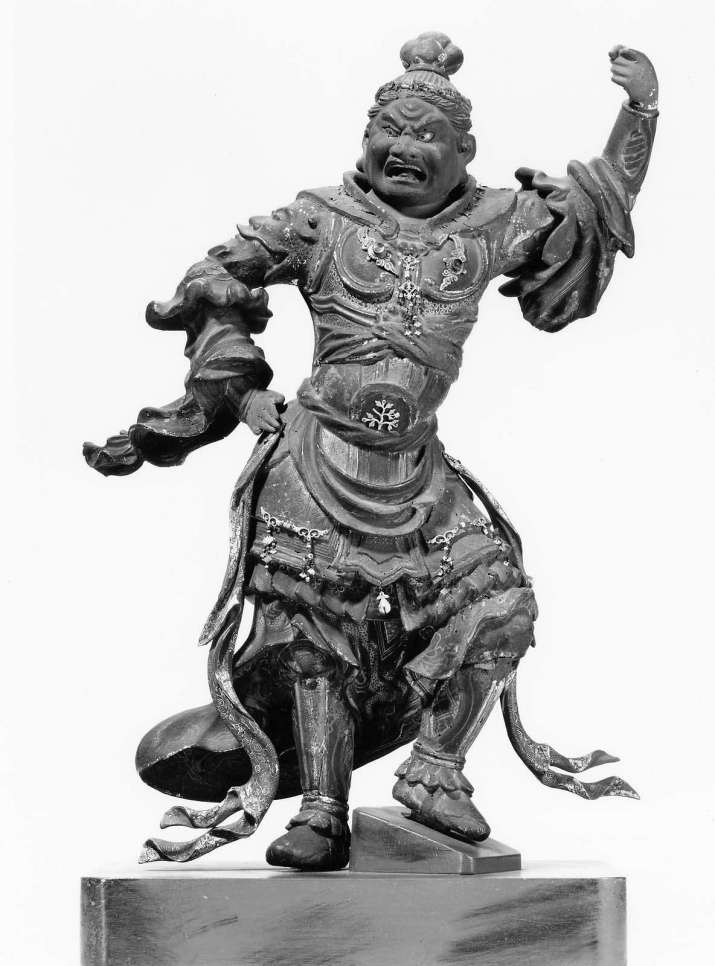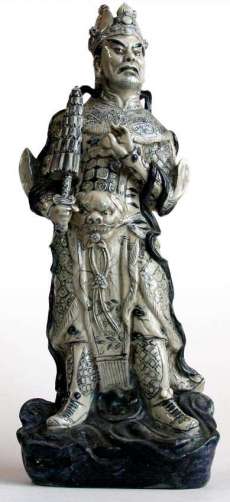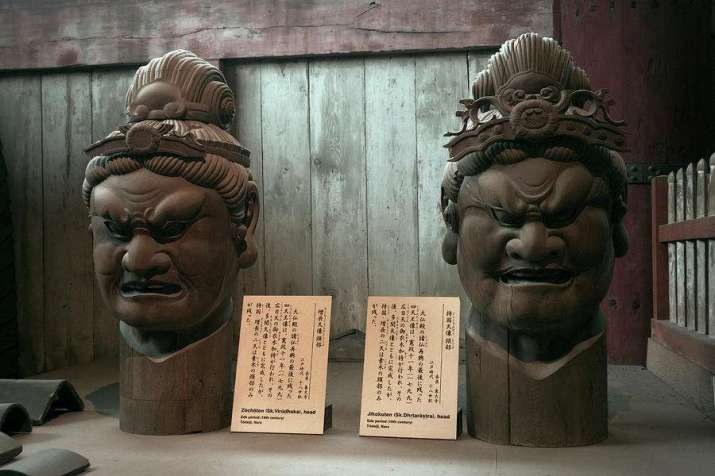
Buddhist teachings, especially those of the Mahayana and Vajrayana schools, call upon a vast number of deities who work for the benefit of mortal beings subject to the cycle of rebirth. These deities can be divided into a hierarchy of four major classes: the buddhas (Jpn: butsu), the bodhisattvas (Jpn: bosatsu), the wisdom kings (Jpn: myо̄о̄), and celestial beings (Jpn: tenbu).
Each class takes on a form that is appropriate to its role within the cosmos; as protectors and guardians, the celestial beings simultaneously terrify evil and encourage those who seek their protection. They are, for the most part, pre-Buddhist Indian deities who were converted and adopted as defenders of the Three Jewels of Buddhism: the Buddha, the Dharma, and the Sangha.
Among the celestial beings are counted the Guardian Kings of the Four Directions (Jpn: shitennо̄): Vaisravana (Jpn: Tamonten; north), Dhrtarastra (Jpn: Jikokuten; east), Virudhaka (Jpn: Zо̄chо̄ten; south), and Virupaksa (Jpn: Kо̄mokuten; west).
The Buddhist universe is divided into three regions that correspond with ethical categories: Kamadhatu (desire), Rupadhatu (form), and Arupadhatu (formlessness). Jina and adibuddha classifications were incorporated into the system later. These Guardian Kings of the Four Directions belong to the lowest region of six devaloka (realm of the celestial beings) within the Kamadhatu called Caturmaharajakayikas (Jpn: shitennо̄ten).
From their vantages at each cardinal direction on the slopes of Mount Sumeru—the center of the Buddhist cosmos and home of the Buddhist deities—they protect the denizens of the other five devaloka: (in ascending order) the 33 Vedic gods in Trayastrimsa; the judge of the dead Yama; Tushita, the paradise of the bodhisattvas; the Nirmanarati devas; and Paranirmita Vasavartin, the highest of the sensuous realms. The Four Kings report on the words and actions of those in the lower mortal realms—of humans, asuras, animals, hungry ghosts, and hellish beings—to the divinities in Trayatrimsa.
In India, where the concept of directional guardians (Skt: lokapala) first originated, Virudhaka is associated with the south, with the color blue (or sometimes green), and with the season of spring. He rules over a group of supernatural creatures called the kumbhanda, which are described as “pot-bellied gnomes” and as beings who drain the vitality from humans, and over the preta-gati, eternally hungry ghosts who cannot be satisfied.

Attributed to Ming dynasty (1368-1644).
From buddhamuseum.com
Virudhaka is known in China as Mo-Li Hung (Lord of Growth) or as Tseng-chang. In accordance with scriptural translations, he is depicted in the armor of a warrior and carries himself with both the regality of his role as a king and the ferocity of a protector. He sometimes stands with one foot or both feet crushing a demon. The King of the South is often shown with a red face and sometimes wields a powerful implement called the Umbrella of Chaos. This umbrella is made of pearls imbued with a preternatural magic that, upon its raising, veils the universe in absolute darkness. Reversing the umbrella instigates powerful thunderstorms and earthquakes.
Imagery of Virudhaka, along with his counterparts in the Four Guardian King grouping, traveled through China and Korea along with the scriptures which described them. Their likenesses were included in the varied mandala and diagrammatic drawings which provided visual representations based on descriptions in the sutras.

When Virudhaka’s imagery first entered Japan—roughly around the beginning of the seventh century—he came to be known there by the name Zо̄chо̄ten, which means “Lord who expands, Lord who enlarges” (translation by independent scholar Mark Schumacher). Zо̄chо̄ten, like his companions, continued to wear Chinese-style yoroi armor and was given the spear or halberd and a sword as his implements of war.
Zо̄chо̄ten is rarely depicted apart from the shitennou. He appears with them in Japanese devotional paintings—at the outer sections of large mandala with many figures or as more significant figures in smaller variants—and in sculpture, often at guard around a butsudan. He occasionally appears with Jikokuten as an attendant to Amida nyorai. Extant examples of early Zо̄chо̄ten sculpture can be found at Hо̄ryǖ-ji (wood; seventh century) and Kо̄fuku-ji (dry lacquer; attributed to ninth century). An impressively animated wood sculpture of the King of the South, also from the ninth century, is on display in Kǖkai’s Tо̄-ji. A head that would have been joined to a monumental Zо̄chо̄ten is all that remains of an Edo period (1603–1868) restoration attempt at Tо̄dai-ji. Funds ran out before the sculpture could be completed.











